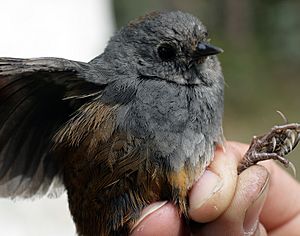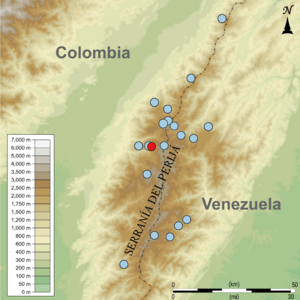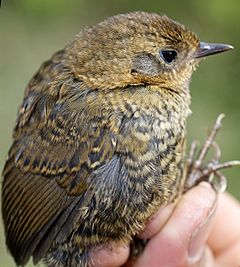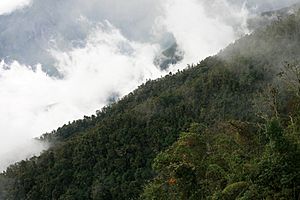Perijá tapaculo facts for kids
Quick facts for kids Perijá tapaculo |
|
|---|---|
 |
|
| Conservation status | |
| Scientific classification | |
| Genus: |
Scytalopus
|
| Species: |
perijanus
|
 |
|
|
Species records
Map of the Serranía del Perijá rangeType specimen |
|
The Perijá tapaculo (Scytalopus perijanus) is a small passerine bird. It belongs to the family called Rhinocryptidae, also known as tapaculos. This bird lives only in the Serranía del Perijá mountain range. This mountain range is located on the border between Colombia and Venezuela.
The Perijá tapaculo lives at high altitudes, from 1,600 to 3,225 meters (about 5,250 to 10,580 feet) above sea level. It is about 10 to 12 centimeters (4 to 5 inches) long. Its tail is about 4 centimeters (1.6 inches) long. Scientists found specimens of this bird a long time ago. However, they officially described it as a new species only in 2015. This happened after sixteen new birds were found between 2008 and 2009. The Perijá tapaculo is considered vulnerable to extinction. This means it is at risk of disappearing.
Adult Perijá tapaculos have grey heads and brown necks. Their backs are striped brown and sepia (a reddish-brown color). Their bellies, chests, and throats are grey-white. Male birds have some light brown marks on their chests. They also have less clear brown spots on the back of their necks than females. This bird is very shy and hard to see. Because of this, scientists do not know much about its daily life. It eats insects and lays eggs between April and July. Parts of its home are protected in the Chamicero de Perijá Bird Reserve in Colombia. It is also found in the Sierra de Perijá National Park in Venezuela.
Contents
About the Perijá Tapaculo's Family
Tapaculos are a very old group of birds. They are divided into 12 groups, called genera, with 60 different species. The Perijá tapaculo belongs to the genus Scytalopus. Many species in this group look very similar. This makes them hard to tell apart just by looking at them.
Scientists often use different methods to identify these birds. They listen to their calls and songs. They also study their mitochondrial DNA. This is like a genetic fingerprint. These methods have helped identify many new species. For example, some birds that looked the same were once thought to be just different types of the Magellanic tapaculo. Now, most of these are known to be separate species.
How the Perijá Tapaculo Was Discovered
Between 1941 and 1942, an American bird expert named Melbourne Armstrong Carriker found 27 Perijá tapaculo birds. He found them in six places in the Serranía del Perijá. He thought they were white-crowned tapaculos, even though they were different in size and color. He sent them to the National Museum of Natural History in Washington, D.C.
In 1953, other scientists started looking at these birds. They thought the birds might be different species. Some even believed they could be a new, unknown species. However, they were never officially classified as a new species at that time.
In September 2006, biologists Juan Pablo López and Alexander Cortés Diago found two more birds. They were in a cloud forest in Colombia. But they did not have enough information to say it was a new species.
Then, from July 2008 to February 2009, sixteen new birds were found. These were in the same area where Carriker had explored. Scientists did new studies on these birds. They looked at their calls, how they looked, their genes, and their environment. These studies confirmed it was a new species. Jorge Enrique Avendaño and his team officially described it on March 11, 2015. This happened after a three-year trip. The name perijanus comes from the Serranía del Perijá mountains. The name Scytalopus comes from Greek words meaning "stick" and "foot."
The first official Perijá tapaculo specimen was an adult male. It was found in the Serranía del Perijá near Manaure, Colombia. This was at 2,450 meters (about 8,000 feet) high. Avendaño attracted the bird by playing a recording of its song. Genetic tests showed that its closest relatives are the brown-rumped, Caracas, and Mérida tapaculos.
Appearance and Features
The Perijá tapaculo is a small bird. It is about 10 to 12 centimeters (4 to 5 inches) long. It weighs about 17 to 18 grams (about 0.6 ounces). Its beak is about 6.8 millimeters (0.27 inches) long. Its legs are about 21 millimeters (0.83 inches) long. Its wings are about 57.4 millimeters (2.26 inches) long. The tail is about 40 millimeters (1.6 inches) long.
The bird's head, neck, and upper back are a neutral grey color. It has a brown spot on the back of its neck. The top of its tail is brown. The bottom of its tail has faint brown stripes. Its back and rump are striped brown and sepia. Its throat, chest, and belly are grey-white. Its lower belly and sides are a light brownish-orange color. Its eyes are dark brown.
Male Perijá tapaculos have less clear brown spots on their necks. The bottom of their chests is mixed with a pale, light brown color. Young birds look yellowish. They have striped brown sides.
The Perijá tapaculo's colors are most like the pale-bellied tapaculo. However, the pale-bellied tapaculo has an entirely brown back and neck. It also has different calls. Young pale-bellied tapaculos have duller colors on their undersides. The Perijá tapaculo, however, has more yellow colors. It also looks like the Caracas tapaculo. But the Perijá tapaculo has duller colors on its belly.
Life and Habits
Like other Scytalopus species, the Perijá tapaculo is very secretive. This makes it hard for people to see it. Its call and song are different from most other birds in its group. Its song is made of two short "churr" sounds. These sounds repeat up to 65 times. There is a short pause of 0.5 to 3 seconds between each sound.
Scientists do not know much about what this bird eats. However, studies of seven birds showed they ate only insects.
Reproduction and Nests
Little is known about how this species reproduces. But scientists believe they build nests between April and July. The birds build round nests in holes underground. These holes are about 12 centimeters (4.7 inches) wide. The nests are about 14.5 centimeters (5.7 inches) high. They line their nests with moss, grass, and plant roots. The main space inside the nest is about 9 centimeters (3.5 inches) wide.
The birds get to their nests through a short tunnel. This tunnel is about 10 centimeters (3.9 inches) deep. It is about 4.2 centimeters (1.7 inches) wide. Young birds may leave the nest by the end of June. Like other Scytalopus species, male birds help take care of the young.
Where the Perijá Tapaculo Lives
The Perijá tapaculo lives only in the Serranía del Perijá. This mountain range is famous for having many unique animals and plants. The bird has been seen in 19 different places. These places are on both the Colombian and Venezuelan sides of the border. It lives at altitudes between 1,600 and 3,225 meters (about 5,250 to 10,580 feet). In the northern part of its range, there are no suitable forests below 1,600 meters.
The Perijá tapaculo lives in and around humid rainforests. It also lives in elfin forests. These are small, dense forests found at high altitudes. It can also be found among woody shrubs in high-mountain grasslands called páramo. It especially likes areas between 2,500 and 3,000 meters (about 8,200 to 9,800 feet). Some birds have been seen eating in thick bushes very close to the ground. Others have been seen running through open grassy areas.
Scientists have not found the Perijá tapaculo living in the same exact places as other Scytalopus species. However, it is possible its home range might overlap with another type of tapaculo. This other bird lives in a different small habitat on the eastern side of the Serranía del Perijá. It might also be found near the pale-bellied tapaculo in the mountains south of the Serranía del Perijá.
Threats and Protection
Scientists who first described the Perijá tapaculo said that its habitat is shrinking. The quality of its home is also getting worse. However, the bird can handle some changes to its habitat. Its natural home covers about 5,000 square kilometers (about 1,900 square miles).
The International Union for Conservation of Nature (IUCN) has classified this bird as "near threatened." This means it could become endangered soon. The scientists believe that more should be done to protect the Perijá tapaculo in Colombia. This is because many forests in the Serranía del Perijá have been destroyed there. This happened due to logging (cutting down trees) and clearing land for farming.
To help protect the bird, the Chamicero de Perijá Bird Reserve was created on January 28, 2014. This was even before the bird was officially described. The Fundación ProAves created this reserve. It helps protect one of Colombia's most fragile habitats. Besides the Perijá tapaculo, other endangered species also live here. These include the Perijá metaltail and the Perijá thistletail. The reserve covers 749 hectares (about 1,850 acres).
In Venezuela, the Sierra de Perijá National Park helps protect the Perijá tapaculo's home. This park is very large, covering 300,000 hectares (about 740,000 acres).
See also
In Spanish: Tapaculo de Perijá para niños




